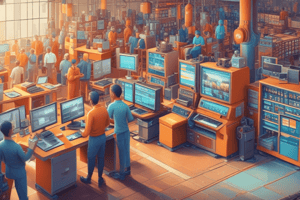Podcast
Questions and Answers
Which of the following actions is NOT related to process management?
Which of the following actions is NOT related to process management?
- Creating processes
- Compiling source code (correct)
- Scheduling processes
- Terminating processes
What defines a process in an operating system?
What defines a process in an operating system?
- A static collection of memory allocations
- A group of related tasks running simultaneously
- A program in execution that progresses sequentially (correct)
- A program in a non-executing state
Which interprocess communication method is based on using shared memory?
Which interprocess communication method is based on using shared memory?
- Sockets
- Remote procedure calls
- Pipes
- POSIX shared memory (correct)
What best describes client-server communication methods?
What best describes client-server communication methods?
In the context of operating systems, what is a primary purpose of process scheduling?
In the context of operating systems, what is a primary purpose of process scheduling?
What does a program become when it is loaded into memory?
What does a program become when it is loaded into memory?
Which of the following is NOT a state of a process?
Which of the following is NOT a state of a process?
What section of memory contains temporary data for functions?
What section of memory contains temporary data for functions?
Which item is stored in the Data section of a program's memory layout?
Which item is stored in the Data section of a program's memory layout?
Which of the following describes a process that is currently executing instructions?
Which of the following describes a process that is currently executing instructions?
When a process is waiting for some event to occur, it is in which state?
When a process is waiting for some event to occur, it is in which state?
What kind of information is contained in a Process Control Block (PCB)?
What kind of information is contained in a Process Control Block (PCB)?
Which action can initiate the execution of a program?
Which action can initiate the execution of a program?
What does the program counter indicate in a process?
What does the program counter indicate in a process?
Which piece of information is NOT included in the CPU registers?
Which piece of information is NOT included in the CPU registers?
What is the primary goal of process scheduling in an operating system?
What is the primary goal of process scheduling in an operating system?
What is the role of the wait queues in process management?
What is the role of the wait queues in process management?
Which of the following best describes a context switch?
Which of the following best describes a context switch?
Which struct is used in Linux to represent a process?
Which struct is used in Linux to represent a process?
What does the 'ready queue' contain?
What does the 'ready queue' contain?
Which of the following information is included in accounting information for a process?
Which of the following information is included in accounting information for a process?
What occurs during a context switch?
What occurs during a context switch?
How does context-switch time relate to operating system complexity?
How does context-switch time relate to operating system complexity?
What limits are imposed by the iOS mobile system for multitasking?
What limits are imposed by the iOS mobile system for multitasking?
How does Android handle background processing compared to iOS?
How does Android handle background processing compared to iOS?
What is a key characteristic of context-switching time?
What is a key characteristic of context-switching time?
What effect does hardware support have on context switching?
What effect does hardware support have on context switching?
In the context of process management, what does PCB stand for?
In the context of process management, what does PCB stand for?
What defines the behavior of background processes in iOS?
What defines the behavior of background processes in iOS?
Flashcards are hidden until you start studying
Study Notes
Process Concept
- A process is a program in execution.
- A program is a passive entity stored on disk and a process becomes active when loaded into memory.
- One program can be several processes, for example, consider multiple users executing the same program.
- Process execution must progress in sequential fashion.
- A process is composed of the program code, current activity (program counter, processor registers), stack (temporary data), data (global variables), and heap (dynamically allocated memory during run time).
Process State
- A process can transition between different states throughout its execution.
- The possible states are: new (being created), running (instructions being executed), waiting (waiting for some event), ready (waiting to be assigned to a processor), and terminated (finished execution).
Process Control Block (PCB)
- The Process Control Block (PCB) contains information associated with each process.
- PCB is also called the task control block.
- PCB information includes: process state, program counter (location of next instruction to execute), CPU registers, CPU scheduling information (priorities, scheduling queue pointers), memory management information (memory allocated to the process), accounting information (CPU used, clock time elapsed since start, time limits), and I/O status information (I/O devices allocated to process, list of open files).
Process Scheduling
- The process scheduler selects which process should be executed next on the CPU core.
- Goals of process scheduling include maximizing CPU use and quickly switching processes onto the CPU core.
- The process scheduler maintains scheduling queues of processes:
- Ready queue containing processes residing in main memory and ready to execute
- Wait queue holding processes waiting for an event (i.e., I/O)
- Processes migrate among the various queues based on their state.
Context Switch
- When the CPU switches to another process, a context switch occurs, saving the state of the old process and loading the saved state for the new process.
- The context of a process is represented in the PCB.
- Context switch is pure overhead, as the system does no useful work during the switch.
- The more complex the OS and the PCB, the longer the context switch.
- Hardware support can influence context switch time. Some hardware provides multiple sets of registers per CPU, allowing multiple contexts to be loaded at once.
Multitasking in Mobile Systems
- Some mobile operating systems (e.g., early iOS versions) restrict execution to one process at a time, while others are suspended.
- The user interface of iOS limits it to a single foreground process controlled by the user and multiple background processes in memory with restrictions.
- iOS background processes are subject to limits including single, short task, receiving notification of events, and specific long-running tasks (e.g., audio playback).
- Android allows foreground and background processes with fewer limitations compared to iOS.
- Background processes in Android can use services to perform tasks.
- A service can keep running even if the background process is suspended and has no user interface with small memory usage.
Studying That Suits You
Use AI to generate personalized quizzes and flashcards to suit your learning preferences.




